The
Irvine Ranch Water District San Joaquin Marsh and Wildlife Sanctuary, also known as the
San Joaquin Wildlife Sanctuary, is 300 acres of constructed wetlands (the "Sanctuary") owned by the Irvine Ranch Water District ("IRWD"). San Diego Creek runs adjacent to the east of the Sanctuary, next to Riparian Way, as well as the Michelson Wastewater Treatment Plant owned by the IRWD. The Sanctuary is in the flood plain of San Diego Creek. A series of six large ponds surrounded by bulrushes, labeled 1 through 6, and five smaller ponds, labeled A through E, which are next to the wastewater plant, allow the water to percolate through it, downhill, removing nitrates from the creek water before it empties back into San Diego Creek and into Upper Newport Bay. The wastewater facility owned by the IRWD does not enter into the Sanctuary. The ponds take up most of the east and south portion of the Sanctuary, while additional land planted with native plants designed to attract birds, along with nesting boxes, are situated over the remaining north and eastern portions of the Sanctuary. Construction of the Sanctuary began in 1988 and was completed in 2000.
Judy and I visited on January 15 and I made another short visit on January 17. Photos of some of the birds I saw follow:
 |
| Most of the ducks we saw were in Pond C. Lots of them were cinnamon teals, a duck I've not seen much of. They are spectacularly beautiful. |
 |
| Another duck in large numbers in Pond C were gadwalls. I'd only ever seen them once or twice before, from a great distance and got poor photos. This experience helped me get to know them much better. |
 |
| Northern shovelers were also in Pond C, but not in as great a numbers as the first two ducks. |
 |
| Pond C also had one of the best collections of ruddy ducks I've ever seen. They are more solitary than the ducks above, continually diving for aquatic plants below the surface of the water. |
 |
| I saw a few buffleheads on Pond C, this one a female, also a diving duck that disappears below the water on a continuous basis. |
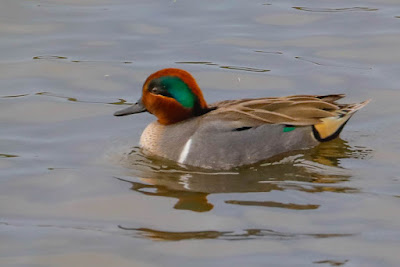 |
| There were just a few green-winged teals among the ducks on Pond C. |
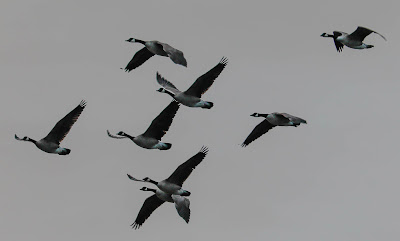 |
| We got there early in the morning and saw Canada geese flying in and out. |
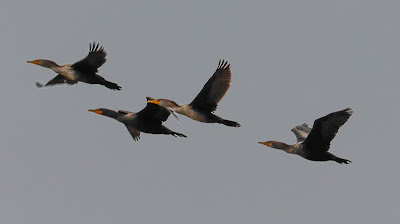 |
| We also saw some double-crested cormorants flying out... |
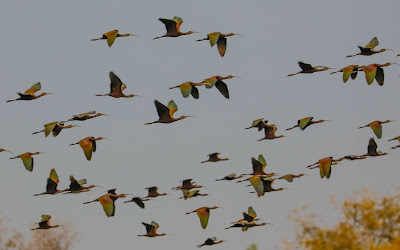 |
| ...and some white-faced ibis flying out |
 |
| ...and a small group of them standing in Pond D. |
 |
| I saw several yellow-rumped warblers. |
 |
| A couple of white-crowned sparrows. |
 |
| A couple of blue-gray gnatcatchers, a first for me, but the photos were all poor. |
 |
| A couple of black phoebes... |
 |
| ...and several song sparrows. |
 |
| A bushtit |
 |
| A common yellow-throat, a first for me, for which I got several horrible photos. |
 |
| Several say's phoebes. |
 |
| Least sandpipers |
 |
| A black-necked stilt. |
 |
| An American avocet |
 |
| Several Anna's hummingbirds. |
 |
| A few American white pelicans. |
 |
| Clark's grebe |
 |
| Western grebes |
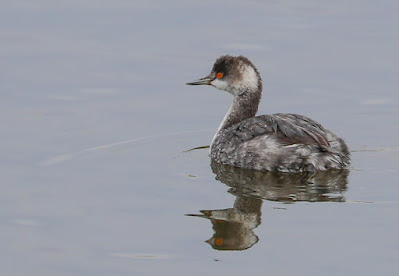 |
| Several eared grebes. |
 |
| A pied-billed grebe. |
 |
| Several red-tailed hawks. |
 |
| Peregrine falcon. |
 |
| A hooded merganser, only the second one I've ever seen. |
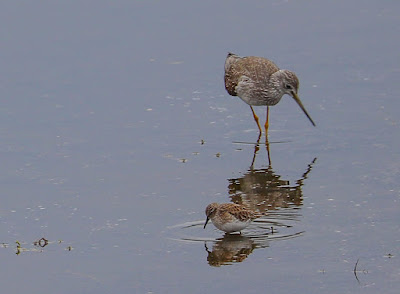 |
| A greater yellowlegs. |
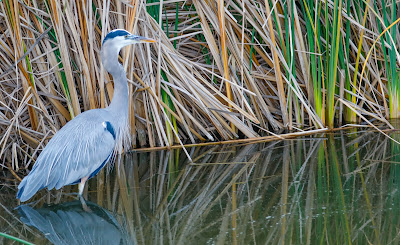 |
| A number of great blue herons. |
 |
| A great egret. |
 |
| Some long-billed dowitchers. |
 |
| A few mallards, particularly out in the wooded areas near small streams as opposed to the ponds. |
 |
| Mourning dove |
 |
| And several northern harriers. |
I visited again on November 19, 2022 and did not see the same quantity or diversity of birds. I did see a number of birds not seen on prior visits.
 |
| Allen's hummingbird was a first for me, anywhere. |
 |
| A black-crowned night heron. |
 |
| Double-crested cormorants. |
 |
| Better views of the American white pelican. |
 |
| Great views of some roosting turkey vultures. |
I visited on January 7, 2023. Here are some of the birds I saw:
 |
| I saw another Allen's hummingbird, but this one showed me its radiating red neck feathers. |
 |
| An American coot. |
 |
| American wigeons |
 |
| Better photos of a blue-gray gnatcatcher. |
 |
| Many cedar waxwings. |
 |
| An Egyptian goose. |
 |
| Great egret |
 |
| Northern pintail |
 |
| Nesting osprey |
 |
| Red-winged blackbirds |
 |
| Snowy egret |























































































That's incredible biodiversity. It's amazing to me that a relatively small area (yet large enough to get lost in, haha) can attract and support such variety.
ReplyDelete